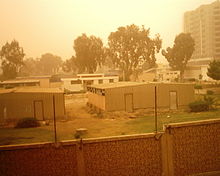Khamsin
| Khamsin in hieroglyphs | |||||
|---|---|---|---|---|---|
Resetyu Rstyw The south winds | |||||
NASA/EOS ) | |||||
Khamsin,
From the Arabic word for "fifty", these dry, sand-filled windstorms blow sporadically in Egypt over a fifty-day period in spring, hence the name. The term is also used in the southern Levant (Israel, Jordan), where the phenomenon takes a partly different form and blows both during spring and autumn.[2]
When the storm passes over an area, lasting for several hours, it carries great quantities of sand and dust from the deserts, with a speed up to 140 kilometers per hour (87 mph; 76 knots), and the humidity in that area drops below 5%. Even in winter, the temperatures rise above 45 °C (113 °F) due to the storm. The sand storms are reported to have seriously impeded both Napoleon's military campaigns in Egypt as well as Allied-German fighting in North Africa in World War II.[citation needed]
In the southern Levant it takes the shape of an oppressive weather front with hot temperatures, large quantities of dust impeding visibility, and strong winds during the night.[2] In the Book of Exodus of the Hebrew Bible, the ruah kadim (רוח קדים) or "east wind" is the cause of the parting of the Red Sea (Exodus 14:21).[2]
Causes
Khamsin can be triggered by extratropical cyclones that move eastwards along the southern parts of the Mediterranean or along the North African coast from February to June.[3]
Regional aspects
Egypt
Characteristics
In
In history
During
- Allied and German troops were several times forced to halt in mid-battle because of sandstorms caused by the khamsin... Grains of sand whirled by the wind blinded the soldiers and created electrical disturbances that rendered compasses useless.[9]
Palestine
The word khamsin is considered a recent import to Palestine, probably introduced during the Mandate for Palestine period by British soldiers who had served in Egypt.[10] Here the khamsin (חמסין) is more often known as simoom (سموم) by the Arabic speaking population, or by the Modern Hebrew name sharav (שרב) by Hebrew speakers. [11]
Khamsin and sharav are scientifically defined as different phenomena, a sharav having three characteristics: a temperature higher than 27°C, a temperature exceeding the annual average by at least 5°C, and humidity levels 10% lower than normal.[10] However, this usage is strictly academic, and the two terms are used interchangeably by common speakers of Hebrew.[10]
For information about the period when the khamsin affects Palestine, see above under "Egypt" (Counting of the Omer, the 49 days between the festivals of Passover and Shavuot).
Cultural references

- In the book Warlock in the Ancient Egyptian series by Wilbur Smith, Nefer, Taita and Mintaka have to hide in a cave until this storm passes whilst escaping the Hyksos
- Khamsin was the name of a magazine published during the 1970s and 1980s by a group of Israeli Middle Eastern exiles in Europe, including members of Matzpen.[12]
- Academy Award for best foreign-language film in 1983.[14]
- The Alexandria Quartet by Lawrence Durrell also has a vivid description of the Khamsin.
- "Khamsin" is the name of the third movement of the composition Warm Winds, recorded by the Hollywood Saxophone Quartet in the 1950s.
- "Khamsin" was the codename of one of the characters from the video game Metal Gear Rising: Revengeance.
- "Khamsin" was the name of a Flame Haze in the anime, Shakugan no Shana.
- In Golden Sun : Dark Dawn, Khamsin is the French name given to the Jupiter Djinni Sirocco
- The Maserati Khamsin is a grand tourer produced by Maserati between 1974 and 1982.
- In The Adventures of Tintin, in the volume "Land of Black Gold", Tintin, his dog Snowy and the twin detectives Thomson & Thompson face this storm.
- The Khamsin appears as a mythological creature in the Spanish comic series A Través del Khamsin, created by Skizocrilian Studio and published by Norma Editorial between 2013 and 2016.
See also
References
- ^ Khamsin at the Encyclopædia Britannica
- ^ a b c d Philologos, Fifty Days and Fifty Nights, in The Forward, 4 April 2003. Accessed 18 May 2018
- ^ Giles O.B.E, Bill. "The Khamsin". bbc.co.uk. Retrieved 2008-08-15.
- ^ OED online.
- ^ Humphreys, Andrew (2002). Cairo. Victoria: Lonely Planet. p. 19.
- ^ Lane, Edward William (1973 [1860]). An Account of the Manners and Customs of the Modern Egyptians. With a new introduction by John Manchip White. New York: Dover Publications. p. 2.
- ^ Lane, p. 488.
- ^ Burleigh, Nina (2007), Mirage, New York, Harper, p. 135.
- ^ DeBlieu, Jan (1998), Wind, New York, Houghton Mifflin, p. 57.
- ^ a b c Dr. Amos Porat, "Between Khamsin and Sharav", at 07:51. Israel Meteorological Service, 18 April 2021. Accessed 27 May 2023.
- ^ Philologos (April 4, 2003). "Fifty Days and Fifty Nights". JewishForward.com. Archived from the original on 2007-04-26. Retrieved 2007-02-26.
- ^ "Khamsin". Matzpen. Archived from the original on 2014-02-19. Retrieved 2008-08-15.
- ^ Kronish, Amy. "Arabs on Israeli Screens". Archived from the original on 2007-01-26. Retrieved 2007-02-26.
- ^ "Oscar Film Critical of Israel". The New York Times. January 24, 1983. Retrieved 2007-02-26.
